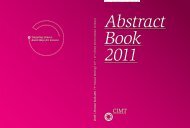Abstract Book 2010 - CIMT Annual Meeting
Abstract Book 2010 - CIMT Annual Meeting
Abstract Book 2010 - CIMT Annual Meeting
Create successful ePaper yourself
Turn your PDF publications into a flip-book with our unique Google optimized e-Paper software.
032 Zelba | Immune monitoring<br />
NY-ESO-1-specific T cells in long-term melanoma survivors<br />
Henning Zelba 1 , Benjamin Weide 2 , Claus Garbe 3 , Graham Pawelec 1 , Evelyna Derhovanessian 1<br />
1 Department of Internal Medicine II, Section for Transplantation Immunology and Immunohaematology,<br />
University Hospital, Tuebingen, Germany<br />
2 Department of Dermatology, Division of Dermatooncology, University Hospital, Tuebingen, Germany<br />
Immunotherapy has now become a potentially<br />
effective cancer treatment modality for certain<br />
patients. Theoretically any protein expressed abnormally<br />
by the tumour can serve as a target for<br />
antibodies or T cells, and there is an ever-increasing<br />
list of possible antigen targets. However, it<br />
is not clear whether targeting particular antigens<br />
can result in a better clinical outcome than others.<br />
Moreover, non-immunotherapeutic treatments may<br />
also result in the generation of immune responses<br />
against certain of these target antigens, which may<br />
be associated with improved patient survival.<br />
To test this, we are analysing exceptionally longterm<br />
melanoma survivors (LTS) in comparison to<br />
patients with bad prognosis who progressed during<br />
treatment and died within the usual time period.<br />
Patients included those receiving chemotherapy ( e.<br />
g. Dacarbazin, Temodal,…) and Immunotherapy (<br />
e. g. IL-2 injection, ...).<br />
We analysed CD4+ and CD8+ T-cell responses<br />
against the four common melanomaassociated antigens<br />
Melan-A, MAGE-A3, Survivin and NY-ESO-<br />
1. Antigen-specific T-cell responses were detected<br />
using peptide mixtures spanning the whole sequence<br />
of the molecule after one round of in vitro<br />
sensitization for 12 days. Intracellular production<br />
of six different cytokines (IFN-γ, TNF, IL-2, IL-4,<br />
IL-10 and IL-17) was measured simultaneously in<br />
both CD4+ and CD8+ T-cells by 14 colour multiparameter<br />
flow cytometry, allowing analysis of<br />
phenotype and function (TH1, TH2, TH17) at the<br />
single-cell level.<br />
In this way, we have identified NY-SO-1-specific T<br />
cells in 7 of 10 LTS but in only 1 of 6 short-term survivors.<br />
The prevalence of T-cells specific for Melan-<br />
A, MAGE-A3 or Survivin did not differ between LTS<br />
and other patients. Similar results were obtained<br />
in an independent vaccination trial targeting the<br />
above antigens. NY-ESO-1-specific immune responses<br />
were found in 3 of 5 patients with a good<br />
clinical outcome after vaccination, but in only 1 of<br />
7 patients with a poor clinical outcome. MAGE-A3specific<br />
responses were induced in the majority of<br />
patients after vaccination, but there was no difference<br />
between LTS and poor responders.<br />
In all LTS patients, as well as in the patients with<br />
good clinical outcome in the vaccination trial,<br />
CD4+ and CD8+ NY-ESO-1-specific T cells produced<br />
high levels of IFN-γ and TNF. In contrast,<br />
NY-ESO-1-specific T-cells in the two patients with<br />
bad prognosis did not produce any or only small<br />
amounts of these cytokines. Taken together, our<br />
data suggest that NY-ESO-1 is likely to be a promising<br />
target antigen for melanoma patients and<br />
might be a good marker to predict the clinical<br />
outcome of individual patients.<br />
75



